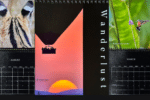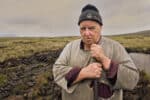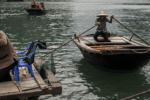In 2001, when I first visited George Divoky on Cooper Island, which is a deserted barrier island off the northern tip of Alaska, it was a forbidding journey into a frigid world of ice and snow. It was June and the Beaufort Sea was frozen, but just beginning its summer thaw, thus making it too dicey for snow machine transit. I had to strap my gear to the pontoons of a small, two-man chopper and be flown by an irascible lug of a pilot to this outpost on the edge of the world. Below is the cover for the magazine I was on assignment for. Even then, as I made this picture of George standing on seemingly endless ice, the big melt was on.

It took me 18 years to get back there. But, finally, with the assistance of Nikon, I returned, this time with a five man documentary film crew. George and I remained friends all these years, and he would keep me up to date on his yearly returns to Cooper. Forty five years ago, as a zoologist with a specialty in arctic sea birds, he began to study a colony of black Guillemot birds who were breeding on Cooper. Over time, though, George’s bird study has become one of the most durable, personally observed, painstakingly documented accounts of global warming in existence. It may well be the largest repository of directly experiential observance of the warming of the planet in existence. As George notes, “I didn’t want to do a study on climate change. Climate change found me.”
The main intent of my revisit was to place George in the exact same place where I shot the NYT cover. Except now, eighteen short years later, he is awash in sea water.
The island is no longer wrapped in snow and ice. It is a stretch of monochrome sand, long and skinny, sitting amidst the turbulent and very liquid sea. The ice is a distant memory and now lives some 300-400 miles off the shores of Cooper. Desperate polar bears now regularly visit the island in a vain search for sustenance, as their traditional hunting grounds have succumbed to warmer and warmer temperatures. The Guillemots suffer, breeding earlier and earlier and with less success. Extinction is knocking on their door. And George, 45 years and counting, continues documenting. To further understand the scope and importance of George’s work, go to: Friends of Cooper Island.
The short documentary film we shot this past July is up on YouTube.
The whole film was shot on Nikon Z6 cameras and S mount lenses, designed for the mirrorless system. More on that to come in an upcoming series of blogs.
Big thanks to a wonderful, hard working crew! Lynn DelMastro was the executive producer, Jon Brundage Jr. was our DOP and ran first camera. Mike Cali ran second camera. Ryan Brooks of Flying Giant Productions did double-duty as audio supervisor and drone pilot. Brett Satterlund shot the Seattle footage in George’s home. Andrew Tomasino shot and edited the behind-the-scenes footage. And our editor Tim Sevigny pulled it all together in his terrific, cohesive edit.
Both the actual film and the BTS of shooting of the film are available on the Nikon Learn and Explore site.
The film goes into wider release, a debut if you will, next week at CES, streaming live on the Nikon Stage, with Mike Corrado moderating the conversation we will have about George and his incredible efforts on Cooper Island. Below is the overall schedule for the Nikon CES stage, with lots of wonderful shooters showing great work. 
Tune in! And…..all the best for 2020! More tk….


















Global warming is a top world subject, with the situation only getting worse. I too have completed some comparison shots and how things have changed, Great read.
Many thanks…the situation is upon us and has to be dealt with….
Joe, this is wonderful what great work by all of you! Hope to reconnect at some point
Your comparative images of George vividly and forcefully make the point.
That is an incredible amount of persistence to study one place for so long. It’s great that you are able to document this even though it’s not a feel-good story.
Those comparison photographs are incredibly powerful. And the contarst between the stillness of the ice and the turbulence of the sea especially poignant. Great work as always.
Wow! I didn’t expect birds inside the box. There were 2 birds inside the box. One looks new born baby.
This is a beautiful example of how a photo can be worth a thousand words! Your photo comparison is a stark reminder that we need to act now to slow global warming.
Global warming is the most important structure now days and recently we facing to manage the twin threats of the corona virus pandemic and climate change, building resilience against both is imperative and urgent. We are going to have to multitask on this one, as delay will cost lives and livelihoods.lets stay home and stay safe